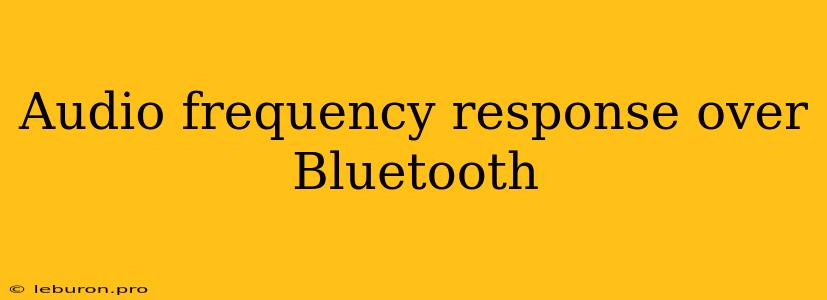The Importance of Audio Frequency Response Over Bluetooth
The quality of audio transmitted over Bluetooth is often a point of discussion among audiophiles and music lovers. While Bluetooth has become the standard for wireless audio transmission, concerns about sound quality, particularly the audio frequency response over Bluetooth, remain. This article explores the complexities of audio frequency response over Bluetooth, explaining how it affects sound quality and the factors influencing it.
H2: Understanding Audio Frequency Response
Before delving into the specifics of Bluetooth transmission, it's crucial to understand the concept of audio frequency response. Essentially, it refers to the range of sound frequencies a device can reproduce accurately. Humans can generally hear frequencies ranging from 20 Hz to 20,000 Hz, with the lower frequencies corresponding to bass and the higher frequencies to treble.
A device with a wide audio frequency response can accurately reproduce a wider range of frequencies, resulting in a more balanced and detailed sound. Conversely, a device with a limited audio frequency response might lack bass, treble, or both, leading to a less rich and nuanced sound experience.
H2: The Impact of Bluetooth on Audio Frequency Response
Bluetooth, while convenient, can introduce limitations to audio frequency response. This is due to several factors:
H3: Compression Algorithms
Bluetooth often employs compression algorithms, like aptX or AAC, to reduce the amount of data transmitted, thereby conserving bandwidth. While these algorithms are efficient, they can sometimes compromise the audio frequency response, potentially leading to a loss of detail in certain frequency ranges.
H3: Bandwidth Limitations
Bluetooth's bandwidth is limited, especially in older versions. This constraint can affect the fidelity of the transmitted audio signal, particularly at higher frequencies. As a result, treble might sound less clear or even distorted when transmitted over Bluetooth.
H3: Codec Limitations
The chosen codec (e.g., SBC, aptX, AAC) can impact audio frequency response. While codecs like aptX and AAC aim to provide higher fidelity than the standard SBC codec, they still have limitations. Each codec has its own specifications, and some may favor certain frequency ranges over others.
H2: Factors Affecting Audio Frequency Response Over Bluetooth
Several factors influence the audio frequency response you experience over Bluetooth:
H3: Bluetooth Version
Newer versions of Bluetooth (e.g., Bluetooth 5.0) offer increased bandwidth and improved data transmission capabilities, leading to potentially better audio frequency response. Older versions, like Bluetooth 2.0, might face greater limitations.
H3: Device Hardware
The quality of the audio hardware used in both the transmitting and receiving devices plays a significant role. High-quality DACs (Digital-to-Analog Converters) and amplifiers can improve audio frequency response, while lower-quality components might introduce distortions or limitations.
H3: Distance and Interference
Signal strength and interference can affect the quality of the Bluetooth connection. If the connection is weak or experiencing interference, the audio frequency response might be negatively impacted, leading to dropouts or audio artifacts.
H2: Improving Audio Frequency Response Over Bluetooth
While Bluetooth does present challenges in terms of audio frequency response, several strategies can help mitigate these limitations:
H3: Choosing the Right Codec
Selecting a high-quality codec like aptX or AAC can significantly improve the audio frequency response over Bluetooth. These codecs offer higher fidelity and a wider frequency range compared to the standard SBC codec.
H3: Optimizing Bluetooth Settings
Some devices allow you to adjust Bluetooth settings, such as the sampling rate or bitrate. Experimenting with these settings can help improve audio frequency response for your specific listening environment and preferences.
H3: Utilizing High-Quality Headphones and Speakers
Invest in headphones or speakers with high-quality drivers and a wide audio frequency response. While Bluetooth itself can introduce limitations, using capable audio equipment can help compensate and provide a more satisfying listening experience.
H2: Conclusion
The audio frequency response over Bluetooth is a complex topic influenced by multiple factors. While Bluetooth does present some limitations compared to wired connections, choosing the right codec, optimizing settings, and using high-quality hardware can help improve sound quality and minimize the impact on audio frequency response. Understanding these factors can help you make informed decisions when selecting Bluetooth audio devices and enjoy a more satisfying listening experience.
